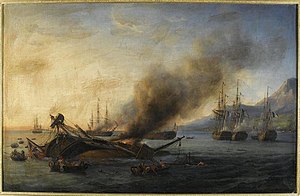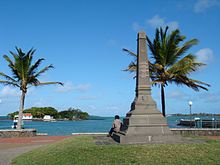Naval Battle of Grand Port
| date | August 23, 1810 |
|---|---|
| place | in the sea area of the island of Mauritius |
| output | French victory |
| consequences | Destruction of a British squadron |
| Parties to the conflict | |
|---|---|
| Commander | |
| Troop strength | |
| 4 frigates | 2 frigates 1 East Indiaman 1 corvette |
| losses | |
|
105 killed |
37 dead |
The naval battle of Grand Port on August 23 and 24, 1810 was an important naval battle during the Mauritius campaign . The French won a major victory and destroyed a British squadron, but this could not prevent the later conquest of Mauritius by the British .
prehistory
After the British conquered the island of Réunion , the Île de la Passe off Mauritius was also conquered on August 13, 1810 in preparation for the invasion of Mauritius. In front of the Île de la Passe only the frigate HMS Néréide remained behind under Captain Nesbit Willoughby , who was supposed to wear down the defense of the island of Mauritius with boat attacks.
On August 20, 1810, five foreign ships were sighted from the Île de la Passe. The ships were a squadron under Victor Guy Duperré with the French frigates Bellone and Minerve as well as the corvette Victor and their prizes, the East Indiaman HEICS Ceylon and HEICS Windham . The French ships sailed into the canal to anchor in Grand Port . At 1:40 p.m., the HMS Néréide and the battery on the Île de la Passe opened fire on the French Victor . The Victor brushed the flag briefly and surrendered, but soon raised the flag again and fled to Grand Port. The Minerve and Ceylon were also shot at, but continued to sail. Even the Bellone was able to reach the port despite being shelled by the Néréide . Only the Windham remained in front of the harbor, but was recaptured the following day by French cannons in a boat attack despite fire protection. The recaptured HEICS Windham was sent to Réunion to notify Commodore Josias Rowley . Captain Nesbit Willoughby demanded the surrender of the Victor from the French commanders, because they had finally surrendered. However, this request was rejected.
On August 22, 1810, Captain Samuel Pym reached the Île de la Passe with the HMS Sirius , in the early morning hours of August 23, the frigates HMS Magicienne under Captain Lucius Curtis and HMS Iphigenia under Captain Harry Lambert.
The battle
At 4:40 p.m. on August 23, the British frigates sailed into Grand Port and the actual fighting began.
The plan of attack
The HMS Néréide was to lie between Victor and Bellone , the HMS Sirius next to the Bellone , the HMS Magicienne between the Ceylon and the Minerve , while the HMS Iphigenia was to lie next to the Minerve .
The failure of the plan
Although the Néréide was able to attack as planned, the Sirius ran aground around 5 p.m. on a reef in the channel. After the three other British frigates had successfully passed the channel, the HMS Magicienne ran aground at 5:15 p.m. on a reef, with only a few cannons able to fire at the enemy. The HMS Iphigenia then anchored and took the Minerve under fire. Meanwhile, from 5:15 p.m., the HMS Néréide fought an artillery duel with Bellone and Victor .
At about 6:15 p.m. the Ceylon took down its flag under the impression of the bombardment by Iphigenia and Magicienne and surrendered. However, the Ceylon set sail and ran aground on the beach. At 6:30 p.m. the Minerve also set sail and followed the Ceylon . However, the Ceylon had also torn the Bellone's anchor cable , which also caused the Bellone to run aground . The Iphigenia cut her anchor in this situation and tried to pursue the Minerve . At 7 p.m., the Néréide's anchor gear was shot away, so that the stern of the Néréide swiveled towards Bellone , which the Néréide fired into the stern. To prevent this, the Néréide turned her little anchor gear and tried again to bring her broadside towards Bellone . The firefight then continued until 10 p.m. During this time, a large part of the crew of the Néréide was already put out of action.
From 10:45 p.m., boats from the Sirius and the Iphigenia tried to get Captain Nesbit Willoughby to leave the Néréide . The Néréide's attempt to surrender by boat to the Bellone also failed. At 12:30 a.m. on August 24, 1810, the main mast of the Néréide went overboard, and at 1:30 a.m., a temporary fire broke out on board the Néréide . At 1:50 a.m., all ships on both sides ceased fire.
At dawn the Bellone opened fire again, and the attempt to hang a French tricolor over the side of the Néréide did not prevent the Bellone from continuing to fire . The British flag of the Néréide had been nailed to the foremast, so this mast was brought down by its own crew. The Bellone then stopped the fire. From 4 a.m. onwards, the HMS Iphigenia retreated by warping out of the harbor .
When the HMS Iphigenia was out of range, the French fire was concentrated on the Magicienne . Captain Pym was still hoping to get the Sirius afloat again. On the afternoon of August 24th, 1810, the crew of the Magicienne received the order to transfer to the Iphigenia . The abandoned frigate was set on fire and exploded hours later. On August 25, 1810, fire was opened on the Sirius with a newly built French beach battery . While the Iphigenia escaped, the Sirius was abandoned at 9 a.m. and set on fire, causing it to explode at 11 a.m.
The HMS Iphigenia sought protection under the Île de la Passe on August 27, 1810. There the frigate cleared the battle and sent the surplus men to the Île de la Passe. On the same day Jacques-Felix-Emmanuel Hamelin reached Grand Port with his squadron from Venus , Manche and Astrée . He asked Captain Lambert to surrender the Iphigenia . On August 28, 1810, the surrender demand was repeated, it was agreed that the frigate and the island would be handed over on August 29, 1810. Although Hamelin had offered an immediate trip home, the governor of the island of Mauritius, General Decaen, demanded and received an unconditional surrender.
Due to the lack of water and the wounded, Captain Lambert surrendered his frigate and the island without any conditions on August 28, 1810.
The court martial honored the four commanders of the British frigates free of any charge of guilt.
Result
It is the greatest French naval victory in the Indian Ocean in this war. The losses on both sides were very high. On board the Néréide, which had originally had a crew of 281, 92 men died and 137 were injured, some seriously. Only 52 men of the crew got away with skin intact. Five men died and 13 were injured on board the Iphigenia . There were also eight dead and 20 injured on the Magicienne . Only the frigate Sirius suffered no losses as it was out of range of the French batteries. The total losses amounted to 105 dead, 170 wounded and approx. 1200 prisoners. The Néréide was used by the French under her name, but had to be scrapped in Grand Port in 1811. The HMS Iphigenia was used as Iphigenié by the French and later recaptured by the Royal Navy .
According to their own statements, the French had 37 dead and 112 injured. However, these numbers are mostly doubted because they seem too low. At all times it has been customary to declare one's own losses lower in order to make one's own victory look greater. However, since the Bellone was never declared seaworthy again, it can be assumed that the damage to the ship was so great that many crew members on the Bellone were also damaged by cannon fire.
Ships involved
| British ships | Cannons | Ship type | French ships | Cannons | Ship type |
|---|---|---|---|---|---|
| HMS Sirius | 36 | frigate | Bellone | 40 | frigate |
| HMS Iphigenia | 36 | frigate | Minerve | 40 | frigate |
| HMS Magicienne | 36 | frigate | Victor | 18th | corvette |
| HMS Néréide | 36 | frigate | Ceylon | 24 | ex HEICS East Indiaman |
Commemoration
The Grand Port Battle Memorial was erected in Mahébourg to commemorate the battle . The monument in the form of an obelisk is a listed building .
Belletristic reception
Patrick O'Brian portrayed the battle in his novel Secret Mission Mauritius .
Specialist literature
- Richard Woodman : The Victory of Seapower. Winning the Napoleonic War, 1806-1814. Mercury Books, London 2006, ISBN 1-84560-012-6 , pp. 92-97.



